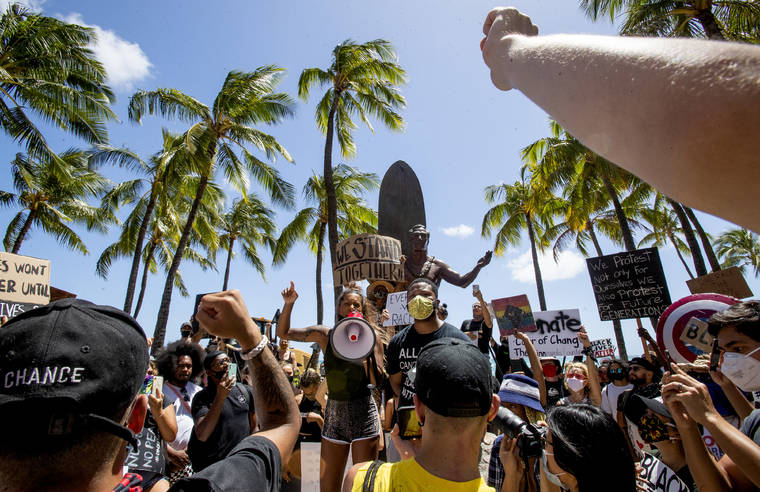On Friday at noon at Ala Moana Park, the protest began with these words:
“This is not a movement against police. This is a movement against police brutality. This is not a movement against white people. This is a movement against systemic racism. This is not a movement against ‘all lives matter,’ but rather, this is a movement that understands that all lives can’t matter until black lives do.”
Estimates of the number of people who joined in the Black Lives Matter march varied from “hundreds” to “at least a thousand.” Crowd estimation is a specific skill that few people seem to have, but that crowd felt bigger than a number.
It felt exponential, like the multiplied will of strangers coming together, kneeling together, lifting their fists together, saying these words together:
“It is our duty to fight for our freedom. It is our duty to win. We have nothing to lose but our chains. We will love and support one another because unity is our best defense.”
The Friday protesters marched into Waikiki Opens in a new tab and gathered around the Duke Kahanamoku statue next to the Waikiki police substation. At that moment, Waikiki felt safer than it has ever felt, kept secure and peaceful by a crowd of people with full hearts set on justice.
>> PHOTOS: Protesters march in Waikiki over killings of George Floyd, Breonna Taylor Opens in a new tab
Some stores had boarded up their windows. Security guards stood outside the International Marketplace, the Moana Surfrider and the Outrigger Waikiki Beach.
Police in black and white aloha shirts walked the perimeter of the crowd. Other police officers were on bicycles, and there were many police cars parked on Kalakaua Avenue with blue lights on.
But there was nothing to fear. That false rumor that had spread like a virus on social media about “outside,” “not nice” protesters flying in to Hawaii to cause trouble didn’t seem to keep anyone away from the protest that had been organized by a group of students who had just graduated from Roosevelt High School and decided that their first act as newly minted adults was to speak out against the murders of George Floyd, Breonna Taylor and all black people who have suffered at the hands of systemic racism and police brutality.
The marchers — black, white, Asian, Pacific Islander, kanaka maoli, Middle Eastern, Latin, mixed, old, young, differently abled, LGBTQ, every person who stood, united — held handmade signs bearing their messages:
“An attack against one is an attack against all.”
“We the people say enough is enough.”
“I’m not black, but I see you. I’m not black, but I hear you. I’m not black, but I’m with you.”
“Neutrality is brutality.”
“Silence is violence.”
“With liberty and justice for who?”
“Everybody vs. racism.”
“It’s a privilege to be unbothered by injustice.”
“You had our backs at Stonewall. We have yours now.”
“I may not understand, but I’m with you.”
“Stop killing us.”
It would be wrong to say that the protest wasn’t angry. How could it not be? Peaceful protest is anger without violence. But it wasn’t purely angry; there was fierce hope and determination and the kind of aloha that exists between strangers who want to do right by one another.
Saturday’s march in Honolulu Opens in a new tab was even bigger and just as peaceful. Black Lives Matter marches were simultaneously held on Maui and Hawaii island. On Kauai, the police chief live-streamed a protest paddle-out in Hanalei and spoke of ending racism and racial inequality as he pointed his cell phone camera to show a huge gathering of surfers in the bay.
But the Friday protest, led by teenagers, in some ways set the example.
As the gathering came to a close in Waikiki and people started to walk back to their cars at Ala Moana, one young man, small in stature, was near the end of the line of walkers. His hand-lettered sign read, “With all my heart, I love you,” and he held it above his head so everyone could see.

